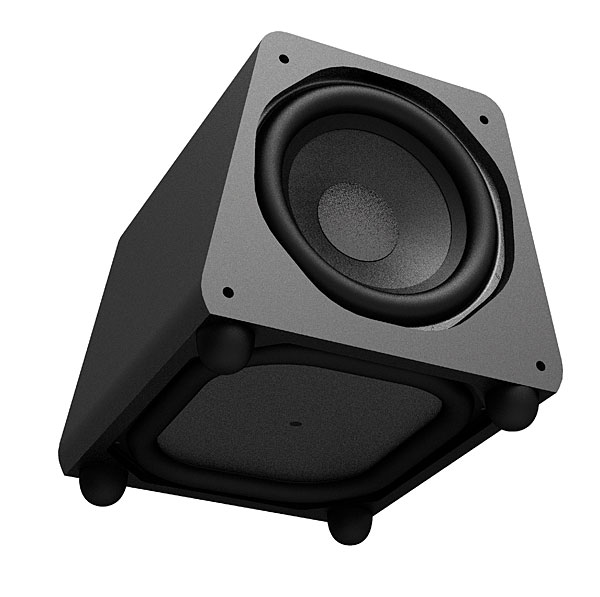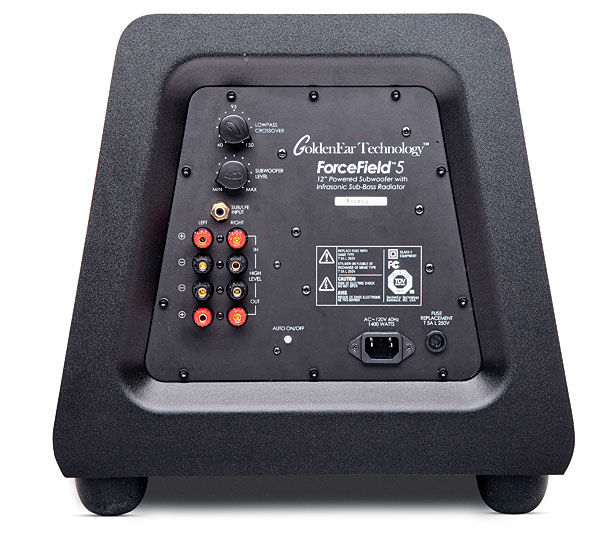It would be great if you guys would do a review of the new supercenters
GoldenEar Technology Triton Seven Speaker System Page 2

Mark Fleischmann wrote about the ForceField 5 subwoofer ($1,000) when he reviewed a 5.1-channel GoldenEar Aon 2 system earlier this year (Home Theater, May 2013). Nothing has changed since then. It’s still the same combination of a proprietary DSP-controlled 1,500-watt switching amplifier packed in a 46-pound, 15-inch-wide x 18-inch-deep x 14.6-inch-tall battleship of a cabinet with an active 12-inch front-firing woofer coupled to a down-firing 12.75 x 14.5-inch planar passive radiator.
Sonic, the Character
I wasn’t expecting much from the movie, Jack the Giant Slayer, but I was captivated from the opening dialogue with one special character not listed in the credits: the movie’s sonic character. I’d anticipated there’d be plenty of chances for the ForceField 5 to strut its passive-aggressive stuff with giants clodhopping about, and that certainly was the case. GoldenEar’s ForceField 5 was frighteningly good at hammering out extremely low frequencies and forcefully sustaining them when required. In addition to all its power, the ForceField 5 was also controlled and snappy, an aspect that made the many, many lightning strikes and thunderclaps in the movie amazingly believable—to the point that more than one thunderous boom made me involuntarily jump
in my seat.

Beyond the boom, the overall acoustical artistry of Jack the Giant Slayer is one that delicately emphasizes the ambience of the scene, whether it’s the high, echoing castle chambers or the breezy, open—and often stormy—air that Jack climbs through on his way to the top of the beanstalk. Of course, one of the hallmarks of a great system is the ability to smoothly transition sounds around the room, such as how the GoldenEar Triton Sevens and companions performed when, near the very beginning of the movie, a giant grabs an unfortunate man and gobbles him up. The way the five speakers carried the poor guy’s screams across the room was superseded in eeriness only by the sounds of the giant’s lips as they closed down over the entire room. Later, when the beanstalk erupts through the floor of Jack’s hut and carries it skyward, thanks to the room-moving low-frequency extension of the ForceField 5 combined with the seamless interplay of the Triton Sevens, the SCX, and the Invisa 650s, the sensation of a powerful—viscerally evil—force ramming its way up was frighteningly palpable. Short of adding a $10,000 D-Box motion simulation couch to your system, I can’t think of a way to improve what the Triton Seven system was able to do with that scene.
The Call, as you might expect since it’s a story centered around a 911 emergency phone call, is a movie that’s heavily dependent on dialogue with intricate shifts in the tones of voices and the clues that can be found in elusive background sounds. I didn’t find it surprising at all that the SCX blended so smoothly with the Triton Sevens thanks to such similarity in the voicing of each speaker. The sounds of police helicopters, the tapping of a rope on a flagpole, the simultaneous conversations of multiple emergency operators, and the hesitant voice of Halle Berry answering an incoming 911 call were all articulated beauti- fully, regardless of their locations in the room.

Sans their multichannel companions, the Triton Sevens proved they’re not solely a home theater speaker but are a serious, reference-caliber set of speakers for music, as well. They sound natural with an openness that revealed rich layers of detail within the gravelly yin and yang of Lyle Lovett’s and k.d. lang’s voices amidst the country twang of fiddle and steel guitar as the duo plaintively sing “Release Me” from Lovett’s final release (Release Me) from his longtime recording company contract. In the case of the more ethereal tone and tempo of Vampire Weekend’s “Step” (Modern Vampires of the City), the HVFR tweeters simply floated, easy and as unfettered as if gravity didn’t exist, while the side-firing planar passive radiators coupled to the bass drivers were taut and fast. If you’re looking to tear walls down with heavier bass-beat-driven songs, such as Macklemore & Ryan Lewis’s “Ten Thousand Hours” or (yes) “Thrift Shop” (The Heist), the Triton Sevens won’t fool you into thinking they’re as equal to the task as are the powered Triton Threes (or Twos)—but the impressively dynamic bass just might have you peeking behind these sylphlike towers to see if there really is a power cord back there after all.
Conclusion
Somehow, like a guy rolling seven after seven at the craps table, GoldenEar has continued to come up a winner with each new speaker. More than that, the company always finds a way to push the limits in terms of performance, size, and, most amazingly, a whopping overabundance of performance for the price. The Triton Seven is no exception to the winning streak. For music, the Triton Sevens provide rock-solid high-end performance for a decidedly mid-fi price. Listening to them matched with the new SCX center channel, a pair of Invisa 650s, and the ForceField 5, you’ll easily understand why I began this review with a fairy tale. The Triton Seven system is absolutely magical. It’s one that anyone—not just Goldilocks—would find to be “just right.”
- Log in or register to post comments


How are these towers compared to the SVS Ultra Tower Surround Speaker System?
I cant decide if I should go with the SVS Ultra Tower or TritonThree. Which are priced the same at $1000 each.
Or perhaps add a $500 more and get a TrianTwo.

I am looking for anyone who has had a direct comparison of the Triton Threes and SVS Ultra's. I have heard the SVS Prime towers and really, really liked them but the powered sub of Triton Three is quite tempting.
k.




































































